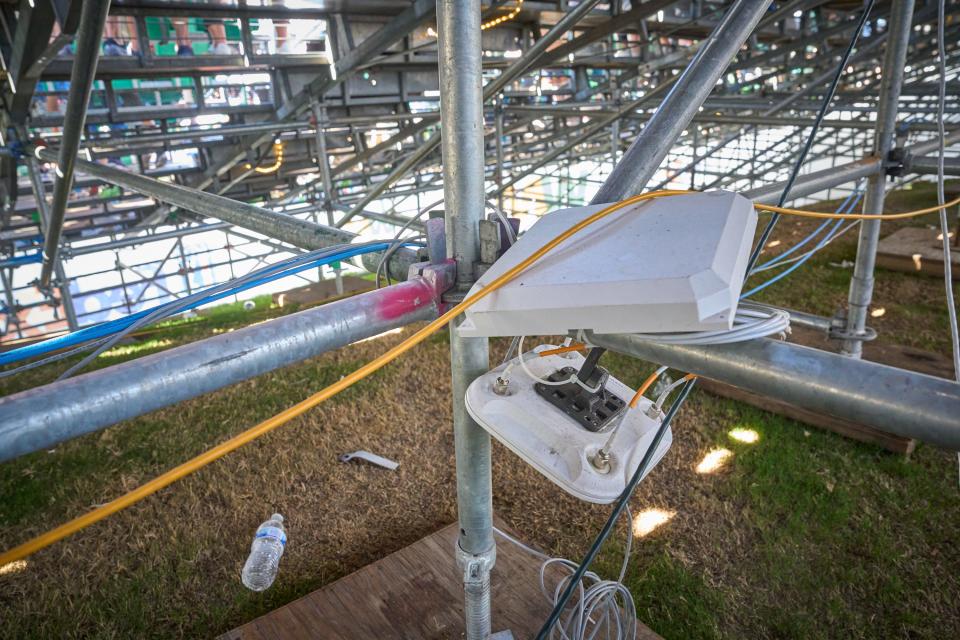'We basically build a little city': Ensuring Wi-Fi works at the Phoenix Open is no small task
Imagine preparing for the cellphone needs of a city roughly the size of Chandler, but just for one long weekend.
That’s essentially what Cox Communications does each year for up to 300,000 daily visitors at the WM Phoenix Open
The goal is for fans to have the same Wi-Fi services anywhere at the north Scottsdale venue as they do at home, including checking email, snapping and sending photos for friends, transferring videos and using apps.
For guests and workers at the tournament, which has mostly gone cash free, that also includes powering thousands of simultaneous Wi-Fi transactions for food, beverages and merchandise, while scanning the bracelets that most visitors wear to gain admission to the tournament and enter various tents and pavilions.
Cox’s technology includes 100 gigabytes of bandwidth capacity and nearly 500 hotspots around the course, each of the latter providing a radius of about 40 feet of cellphone service. The company analyzes patterns from prior tournaments to predict where fans will use their smartphones the most. Hotspots are internet-access locations.
The term gigabyes reflects the speed and capacity at which information can be transmitted, and 100 gigabytes is enough to support up to 300,000 or so users at once, said Andy Carberry, a Cox business field supervisor working the Waste Management Phoenix Open. “Social media needs are a big thing out here.”
Each year, members of the Thunderbirds, the group that organizes and runs the tournament, ask for more technology support, said Andrea Katsenes, a spokeswoman in Phoenix for Cox Communications, which employs about 3,100 people around Arizona.

Heavy use on the 16th hole
Some of the busiest Wi-Fi sites around the course include stands, pavilions, tents, skyboxes and other spots around the 16th, 17th and 18th holes. The 16th is the unusual stadium hole, where grandstands line three sides of the par three in a horseshoe arrangement that one observer described as entering the Roman Coliseum for a gladiator duel. Cox has installed extra fiber lines in those and other areas, including to support evening concerts.
Cox uses 200,000 feet of coaxial and fiber-optic cable above ground, plus 25,000 below ground to support the communications network. That's in addition to various temporary towers on wheels to augment Wi-Fi coverage in high-use spots. The network also powers more than 300 television monitors in pavilions and elsewhere where fans can watch the action.
“We basically build a little city,” Carberry said.
Carberry said the technology is reliable and doesn't keep him up at night, though he occasionally worries if rain or frost moves in because that can hamper his technicians around the greens, where tournament officials restrict access until the delicate grass areas dry out. However, this week’s tournament has had nothing but clear skies.
More technology, more growth
Cox has worked with the tournament for more than two decades, facing increasing technology demands along the way.
One relatively new use involves a DraftKings Sportsbook, where up to 600 people can place wireless bets through their phones at the same time. Then there’s the media center, where up to 100 sports journalists can use their phones and laptops. Cox’s network also powers security cameras around the venue and allows police, fire and emergency personnel to communicate among themselves. “That’s a secure, private network,” Katsenes said.
Although the tournament runs only four days, with practice rounds and various other events wrapped around the golf action, Cox’s staff in Arizona starts planning and preparing nine months in advance. About 75 of the company’s employees are involved. On tournament days, 15 to 20 technicians are on-site.
Reach the reporter at russ.wiles@arizonarepublic.com.
This article originally appeared on Arizona Republic: How Cox Communications builds Wi-Fi network for 300K at Phoenix Open

